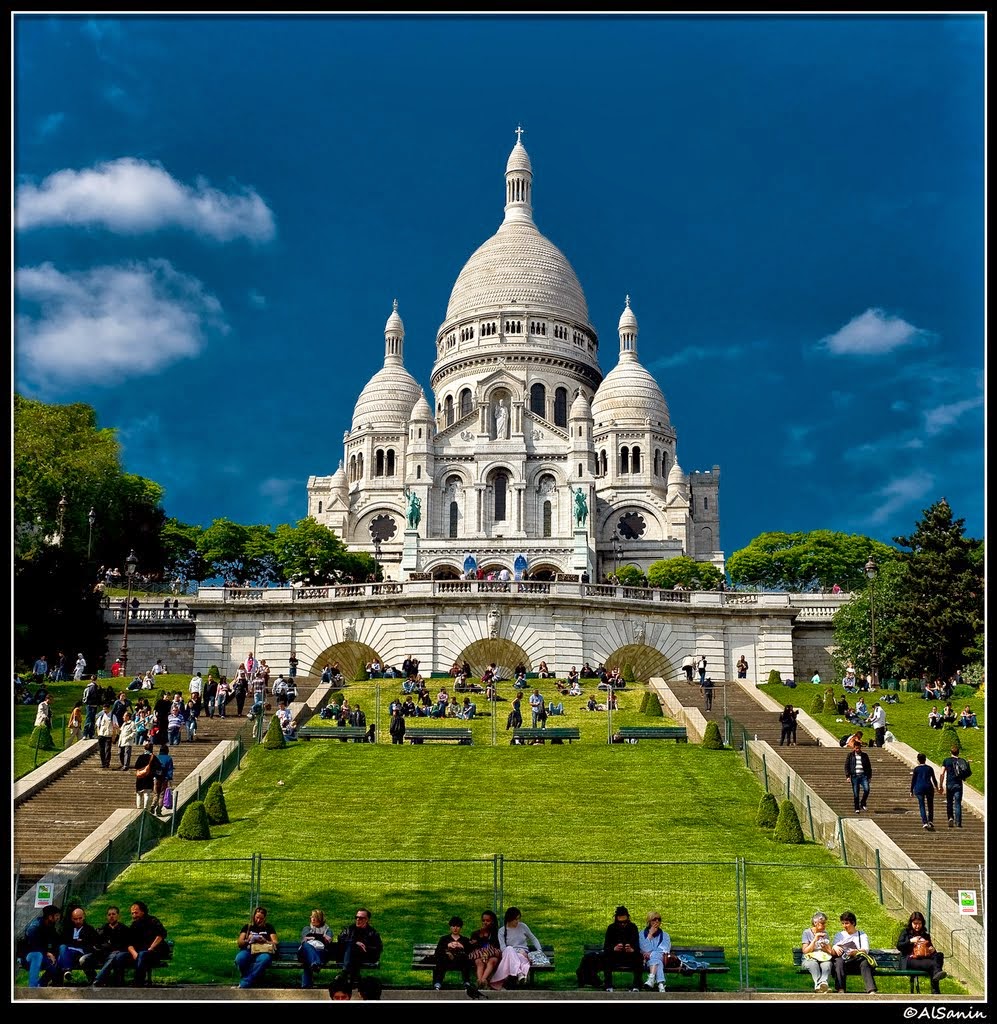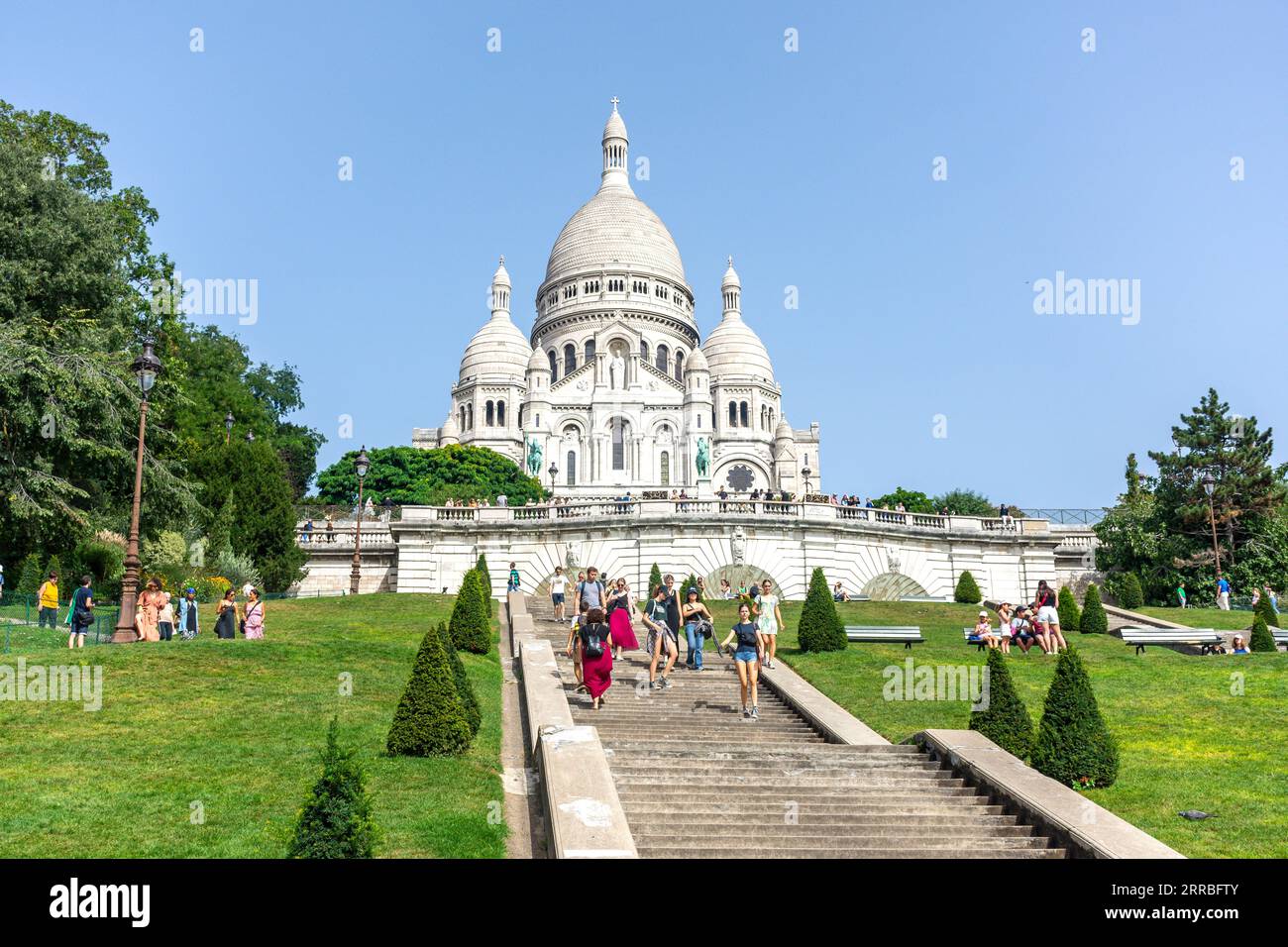The Sacré-Cœur Basilica, a beacon of white stone perched atop Montmartre, is one of Paris’s most iconic and beloved landmarks. More than just a stunning piece of architecture, it’s a place of spiritual significance, artistic beauty, and panoramic views that capture the heart of the city. Planning a visit to this magnificent basilica is a must for any traveler to Paris, and understanding the best way to get there is key to a smooth and enjoyable experience.
This article delves into the Sacré-Cœur’s history, significance, and, most importantly, the most convenient metro stations to reach it. We’ll explore the different metro lines, nearby attractions, and tips for navigating the charming, yet sometimes challenging, streets of Montmartre.
A Brief History and Significance
The Sacré-Cœur Basilica, meaning "Sacred Heart," has a history as compelling as its visual presence. Construction began in 1875 and was completed in 1914, following a vow made by the French National Assembly. The basilica was intended as a symbol of national repentance after the Franco-Prussian War and the tumultuous period of the Paris Commune.
The basilica’s design is a striking example of Romano-Byzantine architecture, a style that was somewhat unusual for Paris at the time. Its bright white travertine stone, sourced from Château-Landon, has the unique property of self-repairing and becoming even whiter with age. This gives the Sacré-Cœur its distinctive, radiant appearance that stands out against the Parisian skyline.
Beyond its architectural beauty, the Sacré-Cœur holds deep spiritual significance. It’s a place of pilgrimage and worship, where visitors can attend Mass, light candles, and reflect in the serene atmosphere. The basilica’s interior is adorned with stunning mosaics, including one of the largest in the world, depicting Christ with outstretched arms.
Finding Your Way: The Nearest Metro Stations
While the Sacré-Cœur is located on a hill, making a direct metro stop at its base impossible, several stations provide easy access to the Montmartre neighborhood and a relatively short walk or funicular ride to the basilica. Here are the most popular and convenient options:
-
Anvers (Line 2): The Most Direct Route
- Why it’s popular: Anvers station is arguably the most direct and frequently recommended metro stop for reaching the Sacré-Cœur. It’s located at the bottom of the hill, on the southern side of Montmartre.
- The walk: From Anvers station, you’ll exit onto Rue de Steinkerque, a bustling street lined with souvenir shops, cafes, and boutiques. Follow this street uphill towards the Sacré-Cœur. The walk takes approximately 15-20 minutes and is a gradual incline.
- The funicular option: For those who prefer not to walk uphill, the Funiculaire de Montmartre is a convenient alternative. It’s located to the right of the stairs leading up to the basilica. A standard metro ticket ("Ticket t+") can be used for the funicular.
- Things to consider: Rue de Steinkerque can be crowded, especially during peak tourist season. Be prepared for a lively atmosphere and take care of your belongings.
-
Abbesses (Line 12): The Quaint and Charming Choice
- Why it’s charming: Abbesses station is located in the heart of Montmartre, known for its artistic vibe and picturesque streets. The station itself is a work of art, featuring Art Nouveau architecture.
- The walk: From Abbesses, you’ll have a slightly longer walk to the Sacré-Cœur, approximately 20-25 minutes. The route takes you through the charming streets of Montmartre, past art galleries, cafes, and the famous "Le Mur des Je t’aime" (Wall of Love).
- Things to consider: Abbesses station is one of the deepest in the Paris Metro system. Be prepared for a long escalator ride or a significant number of stairs. The walk from Abbesses is more uphill than from Anvers, but it’s also more scenic.
-
Pigalle (Lines 2 and 12): A Slightly Further Option
- Why it’s an option: Pigalle station is located on the edge of Montmartre, known for its nightlife and the Moulin Rouge. It’s a slightly further walk to the Sacré-Cœur compared to Anvers or Abbesses.
- The walk: From Pigalle, you’ll walk uphill through the streets of Montmartre for about 25-30 minutes to reach the Sacré-Cœur. The route offers a glimpse into the diverse character of the neighborhood.
- Things to consider: Pigalle is a lively area, especially at night. While generally safe, it’s important to be aware of your surroundings and take precautions against petty theft.
Planning Your Route: Factors to Consider
When choosing the best metro station for your visit to the Sacré-Cœur, consider these factors:
- Your physical condition: If you have mobility issues or prefer to avoid uphill walks, Anvers station and the funicular are the best options.
- Your time: If you’re short on time, Anvers station offers the most direct route.
- Your interests: If you want to explore the artistic heart of Montmartre, Abbesses station is a great choice.
- The time of day: Pigalle can be a more vibrant (and potentially crowded) option in the evening.
Tips for Visiting the Sacré-Cœur
- Dress code: As a place of worship, the Sacré-Cœur has a dress code. Shoulders and knees should be covered.
- Photography: Photography is generally allowed inside the basilica, but flash photography is prohibited.
- Security: Be prepared for security checks upon entering the basilica.
- Crowds: The Sacré-Cœur is a popular attraction, so expect crowds, especially during peak season. Consider visiting early in the morning or later in the afternoon to avoid the busiest times.
- The dome: For a truly spectacular view of Paris, climb to the top of the dome. There is a small fee, and the climb involves a narrow spiral staircase.
- Explore Montmartre: Don’t just visit the Sacré-Cœur; take the time to explore the charming streets of Montmartre. Visit the Place du Tertre, where artists create and sell their work, and discover the hidden cafes and boutiques.
Beyond the Basilica: Exploring Montmartre
Montmartre is a neighborhood with a rich history and a unique atmosphere. Here are a few must-see attractions near the Sacré-Cœur:
- Place du Tertre: The heart of Montmartre’s artistic community, where you can watch artists at work and purchase original artwork.
- Le Mur des Je t’aime (Wall of Love): A beautiful wall covered in "I love you" written in hundreds of languages.
- Musée de Montmartre: A museum dedicated to the history and art of Montmartre.
- The vineyards of Montmartre: Yes, there are vineyards in Paris! The Clos Montmartre produces a small amount of wine each year.
- The Dali Paris: An exhibit dedicated to the works of Salvador Dali.
In Conclusion
Visiting the Sacré-Cœur Basilica is an unforgettable experience. By understanding the best metro stations to reach it, you can plan your trip with ease and enjoy the beauty and charm of Montmartre. Whether you choose the direct route from Anvers, the scenic walk from Abbesses, or the vibrant approach from Pigalle, the journey to the Sacré-Cœur is an integral part of the experience. So, grab your metro ticket, put on your walking shoes, and prepare to be captivated by the magic of Montmartre and the Sacré-Cœur Basilica.


